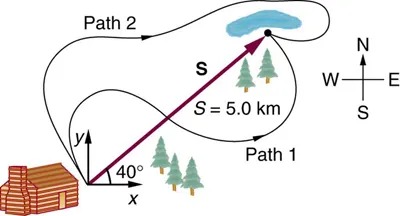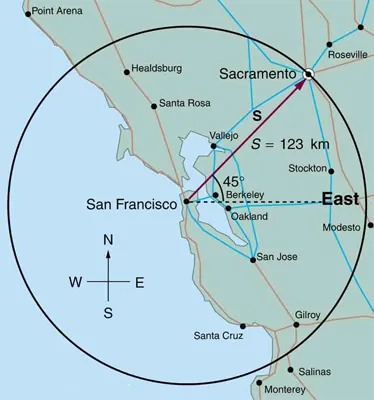Conceptual Questions
Conceptual Questions
3.2 Vector Addition and Subtraction: Graphical Methods
- Which of the following is a vector: a person’s height, the altitude on Mt. Everest, the age of the Earth, the boiling point of water, the cost of this book, the Earth’s population, the acceleration of gravity?
- Give a specific example of a vector, stating its magnitude, units, and direction.
- What do vectors and scalars have in common? How do they differ?
- Two campers in a national park hike from their cabin to the same spot on a lake, each taking a different path, as illustrated below. The total distance traveled along Path 1 is 7.5 km, and that along Path 2 is 8.2 km. What is the final displacement of each camper?

Figure 3.47 Image from OpenStax College Physics 2e, CC-BY 4.0
Image Description
The image is a diagram showing two paths from a log cabin to a lake.
– Log Cabin: Located in the bottom left corner.
– Lake: Shown at the top right corner, represented by a blue shape.
– Paths: There are two winding routes labeled as “Path 1” and “Path 2”. Both paths start from the cabin and end at the lake, taking different, curved trajectories.
– Direct Path (S): A direct straight line marked in red with an arrow pointing from the cabin to the lake. This line is labeled “S = 5.0 km” and crosses through a forest area represented by green tree icons. The angle between the direct path and the horizontal axis (x-axis) is marked as “40°”.
– Axes: An x-y coordinate system is depicted with the x-axis running horizontally and the y-axis vertically.
– Compass: Located on the right side, showing the cardinal directions: North (N), South (S), East (E), and West (W).
The diagram illustrates distance, direction, and angle for navigation from the cabin to the lake.
- If an airplane pilot is told to fly 123 km in a straight line to get from San Francisco to Sacramento, explain why he could end up anywhere on the circle shown in Figure 3.48. What other information would he need to get to Sacramento?

Figure 3.48 Image from OpenStax College Physics 2e, CC-BY 4.0
Image Description
The image is a map detailing a specific area of Northern California, focusing on the cities of San Francisco and Sacramento. Here’s a detailed description:
– Geographical Coverage: The map displays a section of Northern California, showcasing cities such as San Francisco, Sacramento, Oakland, San Jose, Santa Rosa, Stockton, Modesto, and nearby areas.
– Circle and Line: A large circle is drawn on the map, centered near Berkeley, with a line extending from Sacramento to a point on the circle in the direction of San Francisco. This line is labeled with “S = 123 km.”
– Direction and Angle: There is a dotted line representing the East direction from Berkeley, marked with “East” and forming a 45-degree angle with the line from Sacramento.
– Compass Rose: A compass rose is positioned on the map, identifying the cardinal directions: North (N), East (E), South (S), and West (W).
– Additional Details: Cities and landmarks are marked with small dots, and highways or main roads appear as lines connecting them. The circle seems to represent a boundary or radius from a certain point near Berkeley.
This map visually demonstrates the spatial relationship between Sacramento and the San Francisco Bay Area, highlighting directional details and distances.
- Suppose you take two steps [latex]\textbf{A}[/latex] and [latex]\textbf{B}[/latex] (that is, two nonzero displacements). Under what circumstances can you end up at your starting point? More generally, under what circumstances can two nonzero vectors add to give zero? Is the maximum distance you can end up from the starting point [latex]\textbf{A} + \textbf{B}[/latex] the sum of the lengths of the two steps?
- Explain why it is not possible to add a scalar to a vector.
- If you take two steps of different sizes, can you end up at your starting point? More generally, can two vectors with different magnitudes ever add to zero? Can three or more?
3.3 Vector Addition and Subtraction: Analytical Methods
- Suppose you add two vectors [latex]\mathbf{A}[/latex] and [latex]\mathbf{B}[/latex]. What relative direction between them produces the resultant with the greatest magnitude? What is the maximum magnitude? What relative direction between them produces the resultant with the smallest magnitude? What is the minimum magnitude?
- Give an example of a nonzero vector that has a component of zero.
- Explain why a vector cannot have a component greater than its own magnitude.
- If the vectors [latex]\mathbf{A}[/latex] and [latex]\mathbf{B}[/latex] are perpendicular, what is the component of [latex]\mathbf{A}[/latex] along the direction of [latex]\mathbf{B}[/latex]? What is the component of [latex]\mathbf{B}[/latex] along the direction of [latex]\mathbf{A}[/latex]?
3.4 Projectile Motion
- Answer the following questions for projectile motion on level ground assuming negligible air resistance (the initial angle being neither [latex]\text{0}º[/latex] nor [latex]\text{90}º[/latex]): (a) Is the velocity ever zero? (b) When is the velocity a minimum? A maximum? (c) Can the velocity ever be the same as the initial velocity at a time other than at [latex]t = 0[/latex]? (d) Can the speed ever be the same as the initial speed at a time other than at [latex]t = 0[/latex]?
- Answer the following questions for projectile motion on level ground assuming negligible air resistance (the initial angle being neither [latex]\text{0}º[/latex] nor [latex]\text{90}º[/latex]): (a) Is the acceleration ever zero? (b) Is the acceleration ever in the same direction as a component of velocity? (c) Is the acceleration ever opposite in direction to a component of velocity?
- For a fixed initial speed, the range of a projectile is determined by the angle at which it is fired. For all but the maximum, there are two angles that give the same range. Considering factors that might affect the ability of an archer to hit a target, such as wind, explain why the smaller angle (closer to the horizontal) is preferable. When would it be necessary for the archer to use the larger angle? Why does the punter in a football game use the higher trajectory?
- During a lecture demonstration, a professor places two coins on the edge of a table. She then flicks one of the coins horizontally off the table, simultaneously nudging the other over the edge. Describe the subsequent motion of the two coins, in particular discussing whether they hit the floor at the same time.
3.5 Addition of Velocities
- What frame or frames of reference do you instinctively use when driving a car? When flying in a commercial jet airplane?
- A basketball player dribbling down the court usually keeps his eyes fixed on the players around him. He is moving fast. Why doesn’t he need to keep his eyes on the ball?
- If someone is riding in the back of a pickup truck and throws a softball straight backward, is it possible for the ball to fall straight down as viewed by a person standing at the side of the road? Under what condition would this occur? How would the motion of the ball appear to the person who threw it?
- The hat of a jogger running at constant velocity falls off the back of his head. Draw a sketch showing the path of the hat in the jogger’s frame of reference. Draw its path as viewed by a stationary observer.
- A clod of dirt falls from the bed of a moving truck. It strikes the ground directly below the end of the truck. What is the direction of its velocity relative to the truck just before it hits? Is this the same as the direction of its velocity relative to ground just before it hits? Explain your answers.

